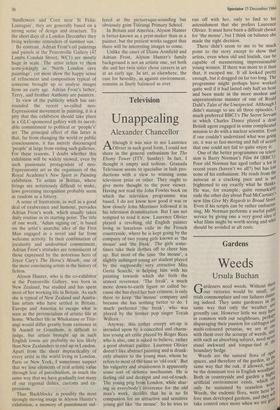Gardens
Weeds
Ursula Buchan
rZardeners need weeds. Without than our victories would be small, Oil trials commonplace and our failures &alit; ing indeed. They unite gardeners in t"d same way that only the weather atte greenfly can. However little we may in common with our neighbours, perhaPo disparaging their passion for cabbages alte multi-coloured petunias, we are at Orld, with them over the scourge of weeds, an f with such an absorbing subject, need nevhee stand awkward and tongue-tied at t" boundary hedge. Weeds are the natural flora of urke spaces, and therefore of the garden, in same way that the oak, if allowed, Ymitd, be the dominant tree in English woodlariv Both in countryside and garden a 410' artificial environment exists, which citic, only be sustained by ceaseless w°,.te, Weeds, the endemic flora, were here fore man developed gardens, and theY v"ile take control once more when we are g°
to our long home. They are the enemies of our childhood, ('do take this broken kitchen-knife and weed between the paving-stones') and they may break us in old age. The sight of a rank and unweeded garden, thistledown on the breeze, is a painful reminder to the elderly of en- croaching and inevitable impotence.
How well we know the common native weeds. Their habits and their ways are as familiar to us as those of our children. We may scarcely notice the sweet scent of the viburnums, and could not say exactly how the crocus grows, but we can spot weed leaves pushing through the soil from many paces. We know that groundsel can set seed even when pulled up in flower, and that the hairy bitter-cress shoots out its seed in all directions when only faintly touched. We know the sow-thistle all too well which mocks our idleness, in failing to fetch a fork to dig it up, by snapping off at ground level when we try to pull it out. Its roots are as tenacious as those of the dandelion, perhaps the most successful of all weeds, for it does not even waste energy on sex, being capable of reproducing with- out fertilisation. Tenacious too are the strong, stringy, yellow* threads of nettle roots and the thin white runners of bind- weed; and who could ever pull up com- pletely the thick cream roots of ground elder? The smallest piece of bindweed, ground elder, or couch grass left in the ground will grow again.
All these I can accept, however, for they are native plants with no especial merit but a strong constitution. They are the wolves in wolves' clothing. Those for whom I reserve most venom are the introductions of nurseries which are still sometimes found in catalogues too timid or calculating to call a weed a weed. I mean the tall, cane-like Polygonum cuspidatum, that grows in boggy ground, and whose roots run about underground; the winter helio- trope, whose wishy-washy but nicely scented flowers come out in February but which has coarse leaves and a fierce will to spread; the Welsh poppy, which spills its seed as carelessly as Onan the budgerigar; and the prettiest wickedest weed of them all, the speedwell Veronica filiformis.
How can we give our cultivated plants a chance against such formidable oppo- nents? The hoe, except in the vegetable garden, is a dangerous offensive weapon. The heedless decapitation of precious nur- tured seedlings is a distressingly familiar experience. There have never been so many weedkillers around — a battery of pre-emergent, residual, systemic and con- tact herbicides. They often work well, at least temporarily, and will justify the ruinous expense, but it should never be forgotten that a dead, or more particularly a dying, weed is one of the most repellant sights in nature. Inglorious in life, they have a way of dying even more inglorious- ly. If sprayed with paraquat, they turn a sere yellow before collapsing; if with glyphosate, the leaves curl in and blacken painfully slowly. It takes nerve to watch.
For the ecologically conscious there is the mulch, of course, which is a covering of the ground with material to keep light from the weeds and so stop their growth. The use of black polythene is highly efficient but not to be contemplated in the flower garden. Compost is good if you can make it, peat if you can afford it, or better still, for those with especially deep pockets, forest bark. You will need inches of it to make any difference and even then the weeds may still grow through. However I do find they pull up easily.
In the end though, whatever our efforts, weeds will defeat us, creeping in here and there, the seeds brought by bird and wind from the gardens of less industrious neigh- bours, or the wild world beyond. There are two ways of coming to terms with them. You can dwell upon their merits. The caterpillars of tortoiseshell, comma, peacock and red admiral butterflies feed on perennial nettles. Ground elder was introduced by the Romans as a cure for gout. The young leaves of dandelion may be eaten in salads. Alternatively, school yourself not to say, when showing friends round, 'I'm so ashamed of the weeds', but point to what is flowering at a distance with such vigour and enthusiasm that they van scarcely notice the carpet of creeping buttercup at their feet.



















































 Previous page
Previous page